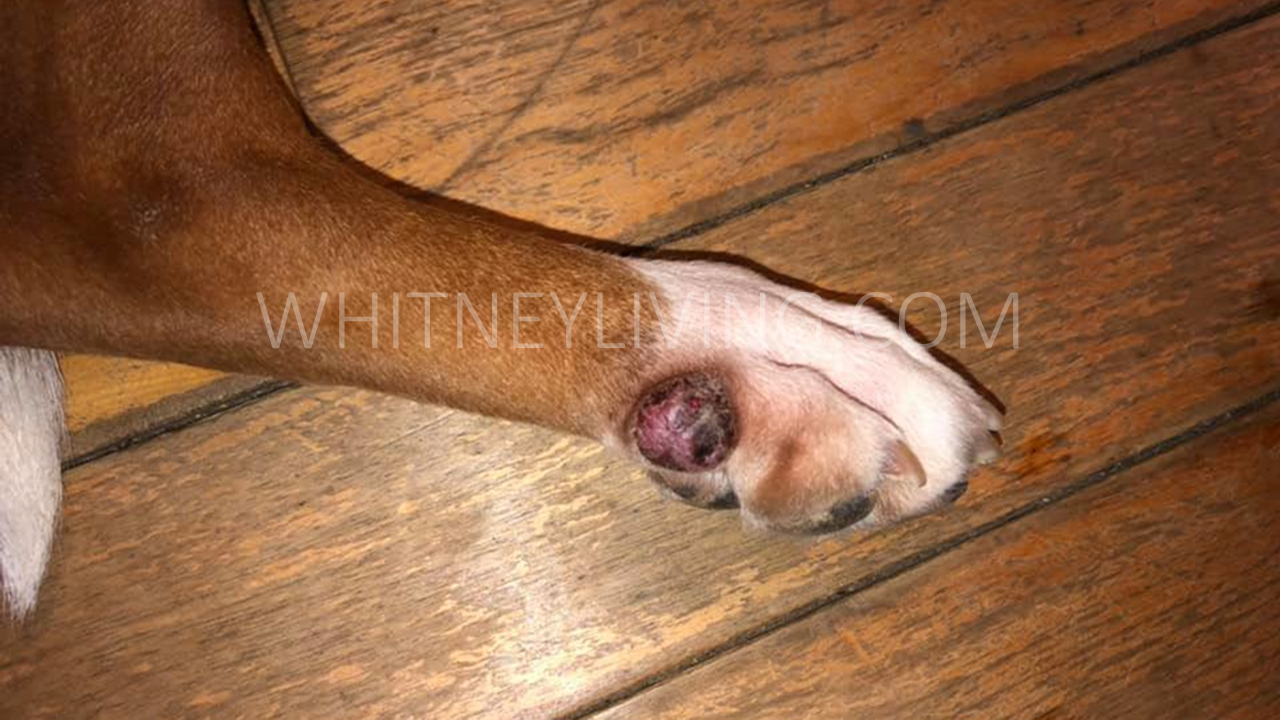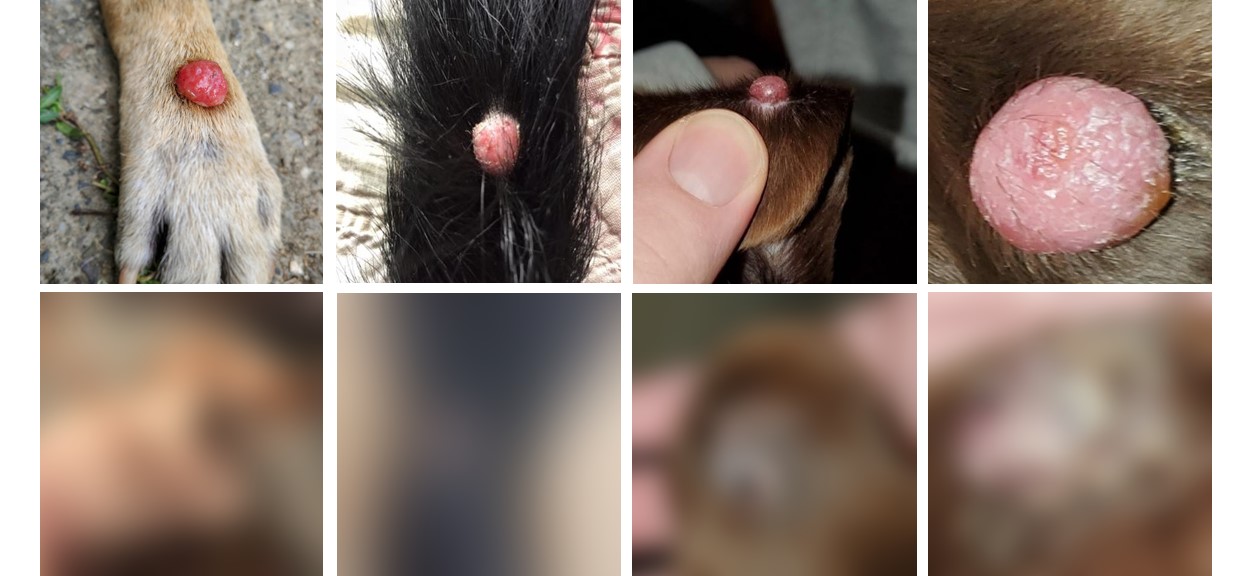There’s an easy fix to histiocytoma dog paw tumors. These scary looking, benign tumors are generally harmless, and more unsightly than they are dangerous to your dog, but to prevent infection it’s best to remove them as soon as you can, and do it with a natural remedy.
Having a histiocytoma show up on your dog’s paw is a little trickier to care for than other places on their body but I have all the tools you need to do so easily and effectively.
Here are some fast facts:
- Histiocytomas are not cancerous in nature (take a deep breath, but also check with your vet)
- Histiocytomas can be removed naturally, at home
- Histiocytomas are completely harmless (most of the time)
- Histiocytomas don’t need surgery (almost never)
- Histiocytomas grow quickly (that’s just what they do)
- Histiocytomas can show up anywhere on your dog
Why Do Histiocytomas Grow On Dog Paws?
Histiocytoma dog paw tumors most often show up on the skin of young dogs. It’s most common for young dogs to get these benign tumors on their faces and extremities, but histiocytomas can quickly pop up just about anywhere on your dog. They can also grow on older dogs as well, it’s just less common.
What caused a histiocytoma to grow on your dog’s paw? Histiocytes are cells that are the immune barrier of your dog’s skin. When histiocytes replicate too quickly they can cause histiocytomas. In other words, histiocytoma’s are an accumulation of too many cells that were trying to protect your dog’s skin against harm. These cells are abnormal because they duplicated too rapidly, but the cells themselves are not harmful to your dog. They were just trying to help.
How Are Histiocytomas Harmful to Dogs?
Histiocytomas themselves are not harmful to dog, unless your dog has a rare case where histiocytomas duplicate rapidly over their entire body. This is so uncommon that there isn’t a lot of information available about it. I’ve only ever heard of one dog that passed away from this condition, and I’ve helped many thousands of people (over 44,000) safely remove their dogs’ histiocytomas over the years.
What can be harmful to your dog when it comes to their histiocytoma is infection. If a histiocytoma becomes infected it can cause a lot of health problems and with severe infection there’s always the risk of death.
Infection can be prevented when you take the right precautions while healing your dog’s histiocytoma. It’s simply a matter of keeping your dog’s histiocytoma from breaking, bleeding and/or becoming dirty.
There are histiocytoma conditions that are not benign, and they are:
- cutaneous histiocytosis
- histiocytic lymphoma
- histiocytic sarcoma
- malignant histiocytosis
- systemic histiocytosis
These conditions are much more aggressive and can be life-threatening but just because your dog has a histiocytoma doesn’t mean they are at risk of any of these diseases. These are very, very, very rare so take another deep breath (and always check with your vet).
What Do Histiocytoma Dog Paw Tumors Look Like?
Finding any kind of bump on your dog can be scary. I remember panicking when I first saw a histiocytoma on my dog Ace. They are especially scary because they pop up out of nowhere and grow quickly.
Here’s what they look like:
- Small
- Fast growing
- Pinkish (or red)
- Smooth
- Solitary (it’s rare for there to be more than one)
- Hairless
They’re mostly found on a dog’s head, legs or tail, but can be anywhere on the body.
My dog Ace first had one on his tail, then later god on in his arm pit.
What Are The Symptoms Of Histiocytoma Dog Paw Tumors?
Histiocytoma dog paw tumors don’t come with many symptoms. Your dog may not even know that they have a histiocytoma. They can be a bit itchy, but not always. If your dog does have any change in health or behavior, always contact your vet.
Diagnosing Histiocytoma Dog Paw Tumors
Your vet should be experienced and knowledgeable enough to look at a histiocytoma and instantly be able to diagnose it as such.
Your vet may recommend a biopsy, but that decision is ultimately up to you.
While all vets should be able to diagnose a histiocytoma with certainty, just by looking at it, an official diagnosis may only be made by getting a tissue sample and examining it under a microscope. This is a simple procedure that can be done in-office. Your vet may also send it off to the lab for further confirmation.
Your vet would perform the biopsy by using a needle or a punch biopsy to take a sample of tissue for examination. They would take a very small sample from the growth. By looking under a microscope they would be able to diagnose by determining the type of cell activity.
Which Breeds Are At Risk Of Histiocytoma Dog Paw Tumors?
Any dog of any breed can get a histiocytoma, but some breeds are more likely to get them than others.
Histiocytomas are more common in these breeds:
- Boston Terriers
- Boxers
- Chinese Shar Pei
- English Bulldogs
- Greyhounds
- Scottish Terriers
What Is The Cost Of Removing Histiocytoma Dog Paw Tumors?
Removing your dog’s histiocytoma should cost no more than $5 if you use the method that I used.
Your veterinarian may suggest surgery (many do) which is costly and almost always unnecessary. Surgery can cost anywhere from $300 – $3,000.
A vet who suggests surgery for something that can regress on its own or be treated with a topical at-home treatment should be questioned.
In the event that a histiocytoma dog paw tumor is infected or otherwise putting the dog a great risk, surgery is a quick and complete treatment.
With that said, I’m here to share my experience with as many people as possible to help them avoid costly and unnecessary procedures.
Click Here for Before and After Pictures and Full Guide
Click Here for Before and After Pictures and Full Guide
Treating Histiocytoma Dog Paw Tumors
Histiocytoma dog paw tumors are easily treatable with at-home remedies.
While histiocytoma dog paw tumors can regress on their own, they regress slowly. It can take weeks or months for them to disappear completely if they’re left alone.
The risk during this time is infection.
If your dog bumps or scratches the tumor, they chance breaking the skin and causing a nasty infection. This is why I treated my dog’s histiocytoma. I didn’t want it to become infected.
It’s best to remove a histiocytoma dog paw tumor as soon as possible.
And by “remove” I mean remove naturally whenever possible.
My method started working right away.
How To Treat Histiocytoma Dog Paw Tumors
Treating histiocytoma dog paw tumors is simple and inexpensive. You may even have all you need to treat histiocytoma dog paw tumors in your pantry!
It should cost about $5 to treat your dog’s bump safely and effectively at home.
First, here’s what I tried that didn’t work…
What Didn’t Work:
- Essential oils
- Witch Hazel
- Tea tree oil
- Frankincense
Luckily for you, I tried all the expensive at-home remedies only to find that they didn’t work. Now I can show you what does! And it’s a pantry item that is a fraction of the cost.
I’ve compiled a complete guide on how to successfully remove histiocytomas naturally.
Click Here for Before and After Pictures and Full Guide
Click Here for Before and After Pictures and Full Guide
Preventing Histiocytoma Dog Paw Tumors
Sometimes abnormalities in the body just happen and aren’t 100% preventable but improving your dog’s health is always a great step towards lifelong health. The best way to prevent abnormalities is by feeding a superior diet and keeping your dog’s environment clean. Improving your dog’s overall health will help them today and later in life.
Talking With Your Vet About Your Dog’s Bump
When it comes to talking with your vet about your dog’s histiocytoma it’s important that you advocate for your dog. Stand up for your dog in a situation like this because many vets will push their clients to choose surgery to remove the histiocytoma. Some will use scare tactics and others will use shame tactics. It’s very rare that surgery is actually needed.
In most cases, surgical removal of histiocytomas is unnecessary. For many years there has been a big overreach by vets regarding removing histiocytomas through surgical procedures.
In very rare cases surgery may need to be performed, but after all these years of helping people with their dogs’ histiocytomas I have never seen one that needed to be surgically removed.
I’ve helped over 44,000 people with their dogs’ histiocytomas and not once did one require surgery. I’ve heard horror stories from people about how their vets treated them, how their vets treated their dogs and the traumas of unnecessary surgeries.
I am here to help spread awareness about this overreach from vets because I don’t want to see you spend unnecessary time and money on something that you can care for at home. I also don’t want to see your dog go through a risky surgery (because surgery is always risky) and then an unpleasant recovery.
The best way to talk to your vet about something like surgery is to ask lots of questions. You certainly don’t want to get in an argument with your vet so instead have these questions handy. It’s best to ask some questions that you already know the answers to so that you know where your vet stands on their knowledge of the issue and what their motivation is for suggesting surgery. If your vet is unethically pushing for an unnecessary surgery, that will become clear to you as you ask questions that you know the answers to and hear their answers.
Questions to ask:
“What is a histiocytoma?”
“Will my dog’s histiocytoma disappear in time?”
“Is my dog’s histiocytoma infected?”
“Is the histiocytoma cancerous?”
“What natural treatments are available?”
“What is the purpose of surgery?”
“What would happen if I opted out of surgery?”
“How common is it for a histiocytoma to not go away?”
After reading this article I hope you have a good idea of what histiocytomas are and have a good understanding of what is needed to heal them.
While you may not know all of the ins and outs to histiocytoma’s and all of the answers to the questions above, I do hope I’ve given you some general knowledge that can help you approach the subject with your vet and listen to their answers with your own new general knowledge in mind.
Most of the time, when a vet is recommending an unnecessary procedure, asking the right questions will help them become less pushy and encourage them to be more helpful and supportive of the decision you make for your dog.

